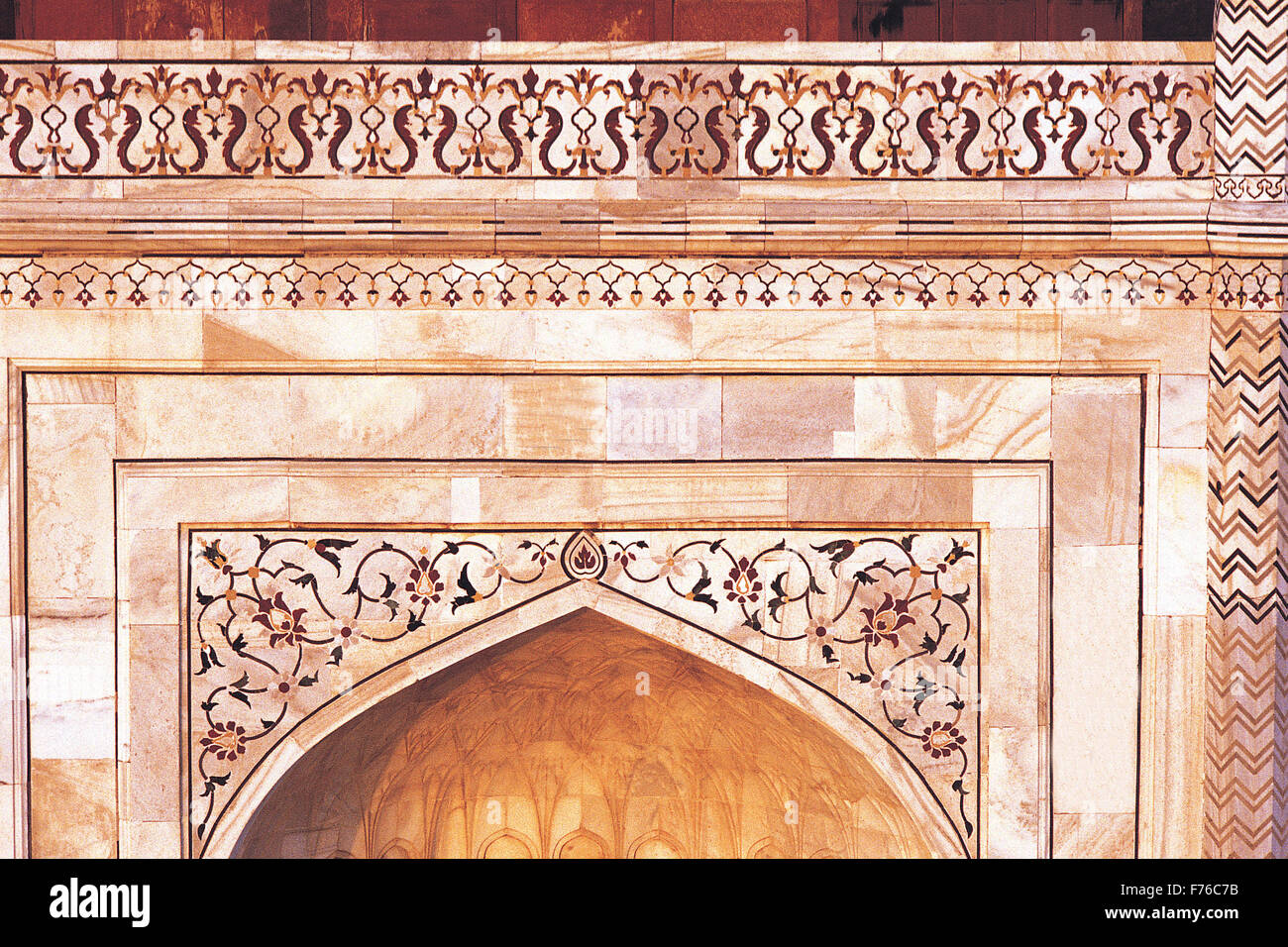Inlay art was a means of dynamic expression throughout the great age of the Mughal Empire and is a noteworthy aspect of Mughal architecture in India. The Monuments of Agra depict the various phases of the Mughal Inlay art's evolution from the sixteenth to seventeenth centuries, as they were created under Akbar (1556–1605), Jahangir (1605–1627), and Shah Jahan (r. 1628-1658). This study will outline potential facets of the history and evolution of Mughal inlay art.
One of the most exquisite and well-known types of Mughal art produced locally in India is marble inlay, or "Pachchikari." Pietra dura, which translates to "hard stone" in Italian, is the technical term for marble that has been inlaid with precious or semi-precious stonework. The goal of the current study is to determine, through recorded sources, whether there is any relationship between the advancement of inlay work and the reign of Jahangir.
India is the country of origin for the Mughal Inlay art, which relied on certain essential elements to flourish locally. Major Kole, Ram Nath, Ebba Koch, E.W. Smith, and V.A. Smith examine certain aspects of the history and evolution of inlay work.
The research demonstrates that it was not only an indigenous Indian art form but also one that flourished under Jahangir. The arguments were based on Jahangir's visit to Mandu (India). When Jahangir visited Mandu, the fascinating inlay work there captured his attention. Jahangir's buildings, including Akbar's Tomb, Salim Chisti's Tomb, and finally the Tomb of Itmad-ud-Dulah, have undergone constant inlay work refinement.
The Origin of Mughal Inlay Art
Regarding its genesis, inlay work, especially on marble or pietra dura, sparked a great deal of discussion. Some claim that inlay art originated in Italy and that Indian artists successfully adapted it to their needs, gave it a local flair, and used the technique to carve out iconic Indian motifs that are still used today.
Some people thought India evolved slowly since we can see the contrasts between the inlay work on the structures constructed by Akbar, Jahangir, and Shah Jahan. Jahangiri Mahal (Plate No. 1), Akbar's Tomb (Plate No. 2, and 3), the Tomb of Salim Chisti, and Itmad-ud-Tomb Daulah's can all be considered as examples of an ongoing growth in inlay art.
Some people thought India evolved slowly since we can see the contrasts between the inlay work on the structures constructed by Akbar, Jahangir, and Shah Jahan. Jahangiri Mahal (Plate No. 1), Akbar's Tomb (Plate No. 2, and 3), the Tomb of Salim Chisti, and Itmad-ud-Tomb Daulah's can all be considered as examples of an ongoing growth in inlay art.
3 Nath underlines that the inlay work found on the Mughal structures created under various emperors is an indigenous art form and, in addition, a developed kind of mosaic that has been further separated into two styles.
The original method involved assembling and arranging various geometrical shapes of stones of various colours to create a pattern on a plaster surface or a stone slab. The other was the inlaid design, which involved placing tiny fragments of semi-precious stones in sockets that were specially created in a slab of marble or sandstone4 (Nath, 1970, 29). The mosaic art in the Buland Darwaja at Fatehpur Sikiri, the Jahangiri Mahal of the Red Fort, and the Akbar's tomb at Sikandara all display geometric shapes in the first style.
The Development of Mughal Inlay Art
Major Cole was cited by Smith V.A. as saying that the Gol Moandal at the Jagmandir Palace in Udaipur, which was constructed for Prince Khurram (Emperor Shahjahan), is the earliest example of pietra dura. 9. The tomb for her father Itmad-ud-Daula was constructed during the same time period (1621–1627) by Nur Jahan, queen of Jahangir, and features nearly identical inlay work of precious and semi-precious stones with various motifs, including floral, cypresses, creepers, wine glasses, birds, and an amazing variety of geometric arabesque (Plate No 6).
Last but not least, during the Shah Jahan era, the Taj Mahal (Plate No. 7 and 9), palaces in Agra (Plate No. 8), and Delhi Red Fort are all rich examples of the highly sophisticated inlay craftsmanship. In agreement with Smith, Shah Jahan "likely learned this technique while staying in the Jagmandir palace at Udaipur.
The Mausoleum in the Ashrafi Mahal (Plate No. 10), as well as the Tower of Victory, were both built in the first half of the fifteenth century, according to Nath.12 If all of this can be possible that Shah Jahan was impressed by the Jagmandir palace at Udaipur, there is also a possibility that Jahangir and his wife were fascinated by Mandu's Inlay work while visiting that place.
A domed Mausoleum and a seven story tower were once part of the Mahmud's Madrasa of the Heavenly Vault (Asharfi Mahal), which is now mostly in ruins in Mandu, Madhya Pradesh, central India13 (Plate No 10). Asharfi Mahal's inlay work cannot be compared to the Mughal inlay work in Agra because it is not now in that condition and no samples of that period's inlay work are available. However, this research is based on Nath's claim that Mandu has the oldest examples of inlaying with rare stones. With the positioning of inlay motifs and the usage of negative and positive space of the inlay motifs, it attained its most elegant position during the reign of Shah Jahan.


Comments
Post a Comment